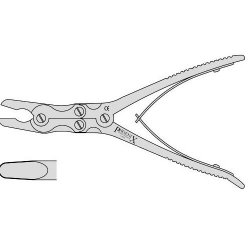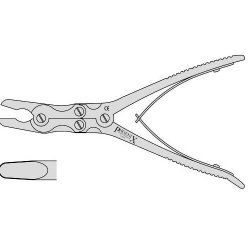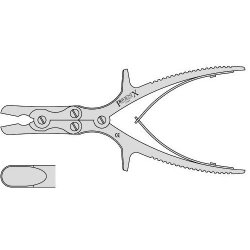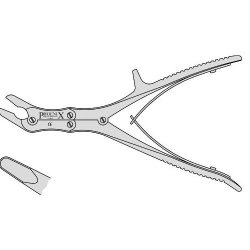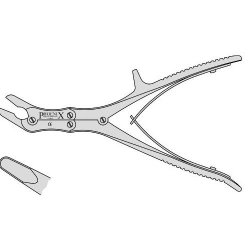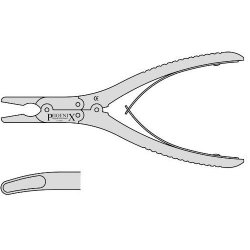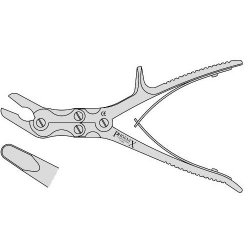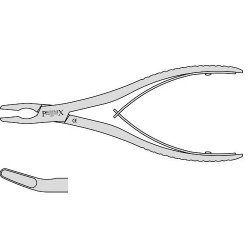Killearn Bone Rongeur With 3mm Bite And Compound Action With Fine Long Jaws 230mm Angled
Killearn Bone Rongeur With 3mm Bite And Compound Action With Fine Long Jaws 230mm Angled.
Quality Assurance
All Health and Care surgical instruments are theatre quality, and are manufactured in the UK to the highest standards in accordance with British Standard accreditation ISO 9001:2000, ISO 13485:2003 and 93 / 42 / EEC.
Health and Care surgical instruments are fully reusable.
Warranty
All Health and Care surgical instruments are supplied complete with a lifetime manufacturer's guarantee against faulty workmanship and materials. It is recommended that electrosurgical instruments and leads are serviced after every 40 uses and that leads are visually inspected prior to every use.
Servicing and Repair of Surgical Instruments
We offer a comprehensive repair service for all surgical instruments. For example, a typical forceps or scissors repair service would include dismantling, cleaning, reassembling, replacing rivets, sharpening and full testing.
Stainless Steel Grades
Health and Care surgical instruments are manufactured using the correct grades of stainless steels specified in BSENISO7153-1:2001 and these are listed below. In this standard, the grades of stainless steel are given a “Reference Letter” which cross references the grades of material.
Grade A, B and C would be generally described as 410 / 420 types and are extensively used for dental and surgical instruments. They are used for applications where cutting edges, wear resistance and strength are required.
Long service lives should be expected from martensitic stainless steel dental and surgical instruments, properly manufactured and subjected to appropriate cleaning procedures.
Health and Care instruments use the following grades:
Artery Forceps and Clamps
Grade B, AISI 420 S29 (AISI 420, SUS 420 J1)
Dissecting Forceps
Grade B, AISI 420 S29 (AISI 420, SUS 420 J1)
Scissors and SuperCut Scissors
Grade C, AISI 420 S45 (AISI 420, SUS 420 J2)
Osteotomes, Chisels and Cutting Edge Single Instruments
Grade C, AISI 420 S45 (AISI 420)
Damaged Instruments
If any instruments have been damaged or are found to be below your standard of expectation, please supply full product details so that we may investigate and rectify the issue.
Washing, Decontamination and Sterilisation of Surgical Instruments
All Health and Care surgical instruments have been inspected for functionality before shipment to theatres. All instrumentation is inspected prior to shipping. Should you experience any problems when using a surgical instrument, please inform our Customer Care Team immediately.
Health and Care’s surgical instruments must be sterilised prior to use using high temperature steam. The instrument must be sterilised using validated equipment and processed in accordance with Health Technical Memorandum 2010 – Sterilisation. Health and Care has no control over equipment and practice in your hospital. The sterility of any instrument is the responsibility of the customer.
To sterilise wrap instrument kit trays and use a steam autoclave. The standard parameters of 134-137 degrees centigrade for 3 – 3.5 minutes are appropriate.
Note: individual autoclaves (even those of the same model) may vary in performance, characteristics and must be validated. Accordingly these aforementioned parameters were achieved during the validation of multi-layer instrument trays. The autoclave used was a vacuum assisted air removal phase prior to steam admission for sterilisation.
For further information relating to the use of these instruments, please contact Health and Care’s Customer Care Team.
For further information regarding cleaning and sterilising, please consult AAMI Technical Information Report (TRI) 12-1994 : Sterilisation, Disinfection and Cleaning of Medical Equipment, Guidance on Decontamination from the Microbiology Advisory Committee to Department of Health Devices Directorate.
After Use – Washing & Decontamination of Surgical Instruments
The decontamination process is dependent upon effective cleaning and washing of instruments. Severe soiling should be removed under running water in a sink draining continuously, using brushes and rigid nylon bristles. Attention should be paid to any cannulated instruments and any screw holes where debris may enter. Staff carrying out the decontamination and washing process should operate according to local policy and procedures.
For automated washing machines a typical cycle should include the following:
-
Cool/warm detergent below coagulation temperature (below 60 degree C)
-
Rinse to remove detergent.
-
Hot wash disinfection (above 71 degrees C for 3 minutes in all part of load).
-
Final rinse in purified water.
-
Heat around drying cycle.
-
The majority of surgical instruments are one-piece items, however some are constructed from several components. These must be disassembled into their constituent parts in order to be washed, cleaned and decontaminated effectively.
Before returning any instrument to Health and Care, please ensure that washing and sterilising has been carried out in accordance with HTM 2010 and HTM 2030. All equipment used must have a validated cycle. The reference numbers should be entered onto the decontamination certificates.


